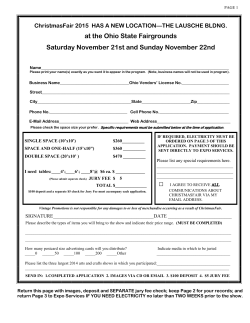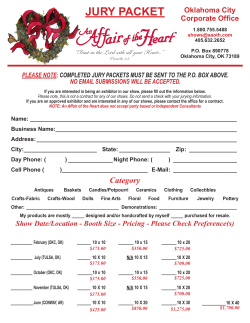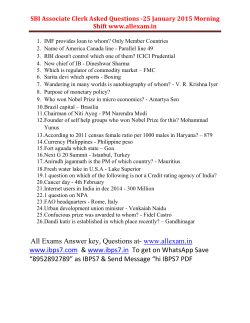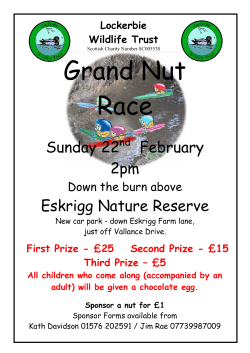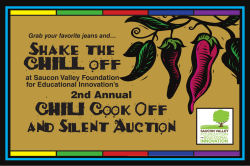
âRe-appropriating the Expo 2010 site and creating urban
“Re-appropriating the Expo 2010 site and creating urban quality with passages” Jury report of the Shanghai competition – 19 March 2015 Composition of the jury Prof Zheng Shilin, academician, Tongji University (chairman) Prof Wu Jiang, Vice president, Tongji University (CN) Xu Yisong, deputy director, urban planning bureau, Shanghai (CN) Stanley Lung, architect, designer, landscaper Turenscape (CN) Marcel Smets, architect, urban planner, president of the IVM Scientific council (B) Didier Rebois, architect, Secretary General Europan, teacher Paris (FR) Excused: Kristian Koreman, landscape architect ZUS (Zones urbaines sensibles) Rotterdam (NL) Presentation of the projects: Jens Aerts: architect, partner of BUUR, & Guest Professor at the Vrije Universiteit Brussels (BE); Bernd Vlay, director of STUDIOVLAY Vienna (AT) Coordination of the competition and report Pan Haixiao, Chairman of IVM China Yuna Conan, project Manager “Passages”, IVM Observer Liu En Fang, architect, president of the Shanghai Institute of Architectural Design & Research (CN) Awarding of the prizes First prize: “Sun + gate - in between space” Pierre-Marie Auffret, Vincent Hertenberger, Agathe Lavielle (FR/CN) Second prize: “Little Happiness” Véronique Hours - Fabien Mauduit - Benjamin Viale (FR/CA) Second prize ex-aequo: “Better city life” Julio de La Fuente, Natalia Gutiérrez, Zheng Jie, Dan Currey, Alvaro Guinea (E/CN) Amounts of the prizes First prize: 4000 Euros Second prize: 2000 Euros 1 General remarks The jury is impressed by the high quality of the presentations and projects and the progress made after the first meeting too days before. The three prizes are unanimously awarded, which proves the high quality of the projects and let foresee possible implementation on the Expo site. The first prize convinced the jury for its strong proposals and its overall consideration of the competition brief. The two second prizes are awarded to creative projects that propose innovation in their way of defining urban design strategies for the site and its particular context. Comments on the 8 projects “Sun + gate - in between space” – FIRST PRIZE Pierre-Marie Auffret, Vincent Hertenberger, Agathe Lavielle (FR/CN) The team proposes two main strategic interventions in the “in-between spaces” to reconnect the site’s potentials: 1) “re-gating”: shifting the limits of the museum entrances and the gated communities- to consider new collective and shared spaces; 2) “re-rooting”: adapting the public transport itineraries (i.e. deviation of the tramway, ferry, cycle paths) in order to address the whole site with a highperformance mobility network ). The project considers the big scale mobility strategies to highlight the value of the site in the long run. It also refers to the four axis described in the brief and proposes a “passage to the river” with focuses on four sequences of shared public spaces on different levels. They also consider the passage according to the time of the day and the respective mix of public, collective and private spaces. They finally propose a long-term strategy for the site linked to the changes of the city and a development of the site in different steps. This is the most complex project with interactions of spatial and temporal scales respondsing fully to the competition brief. “Little Happiness” – SECOND PRIZE Véronique Hours - Fabien Mauduit - Benjamin Viale (FR/CA) The jury is seduced by the story of a human and sensitive approach on the site. The poetical and very innovative presentation of the project, reveals the potentiality of the beauty of the existing Expo site. That could convince the developer to keep some elements of this beauty in the development of the site. If it appears very theoretical, it tells a lot about the uses on the site, the passages and the passers-by, drawing the attention to important things that make the passages more confortable in the day-to-day life. The team proposes a toolbox of very well detailed and designed micro-interventions at human scale, and a more specific intervention on the riverfront. It is more a programme than a project but invites to a really innovative and pertinent answer to the question of passage. 2 It also proposes a different way to understand and represent the urban design: this attention to the “little happiness”, even if implicit, is indeed not presented in big scale master plans, although it is important in the urban dialogue. A recommendation would be to propose Chinese Art in the public space instead of showcasing internationally recognized artists. “Better city life” – SECOND PRIZE Julio de La Fuente, Natalia Gutiérrez, Zheng Jie, Dan Currey, Alvaro Guinea (E/CN) The jury appreciates the complexity of the built-up and the fine methodology of the project that explores spatial structures according to five scenarios (transversal identities, urban filters, centrality, network and social layer) developed in the time. Although the diagrams are abstract, they clarify the content and argumentation for the first phase in time. The idea of the incubators, of the three main parks that connect the site and the thematic passages are also convincing. It is moreover the only project that proposes to make a physical passage, even if very expensive, to reach the other side of the river. However, this complex strategy remains too abstract and should be further developed at the design level. “Transition – gates” Adeline Ageneau, Cecile Brouard, Julie Gangneux, Alpha Kebe , Francois Guibert , Li Miao , Bing Li (FR/CN) The jury appreciates an interesting, unique and multidisciplinary approach, based on a methodology of interviews and observation. It thus considers the site from the users’ perspective through an interpretation of the ritual of the passage (with a reference to the Chinese tradition) and gates as places of transition. The project consists in a subjective map of gates and itineraries with four major itineraries (River parkway-Go to the bank-River bank) with sequences of sensitive experiences. However, the project seems too symbolic and literate. The jury questions the idea’s application of the gates, whose multitude on the site decreases their symbolic strength. Some of the gates presented are strong, others are more naïve, anecdotic and seem to be unable to interact with the scale of the context. Moreover, this approach doesn’t take into account the bandwidth of future users of the site, especially the workers of the Green Valley. “Minecraft: rediscover, re-appreciate, recycle” BudCud, Fundacja Salony, Sławomir Zbiok Czajkowski (POL) This multidisciplinary team with architects and artists doesn’t really design a place but creates an atmosphere through a cultural programme that connects all the different areas of the site and its users on a large open-air loop around the Green Valley, exploring 3 main axis (transversal connection through the river mall; car park in the south with changes according to the seasons; cultural programme and art that explore spaces that don’t have short-term solutions). 3 The jury appreciates the concept of curating urban interventions, in which the inhabitants can participate in the modification of the area, but has strong doubts that the specific proposals for an art park can link the different parts of the site in a satisfying way. The jury moreover regrets that the Green Valley is not considered. This approach of inserting art and pop art culture into no-man lands and abandoned areas doesn’t impose durable guidelines for the future development of the Expo site. The idea of the park continuity and its linkage to the housing district appears in a conceptual, prictogrammatic scheme, not addressing the park design: in this sense there is a gap between the design concept and the art programme. “Passages for coexistences” Mathieu Delorme & Thibault Barbier (ateliergeorges), Chen-yu Zhou, Mathias Rollot, Adèle Sorge (FR/CN) Starting from a wish to overpass the programmatic enclaves of the site by interviewing the uses, the team has done a great progress during the workshop to illustrate his position. The action programme of a shared park on the south of the Green Valley that connect three different scales of inhabited systems (world-class, Chinese culture and river) is clear but appears still too abstract. It remains more the application of a theoretical concept or a brief for a possible intervention than a designed project on the site. “New perspectives on the city: Creating passage(s) on the Green Valley” Atelier Rohan (Philippe Rohan) & 9B+ (Ameline Colombier, Grégoire Chailleux) The jury appreciates the strong and pragmatic proposal to give value to the core of the site: the Green Valley. The team focuses its intervention on the green valley by creating the necessary relations between the Green Valley and its surroundings and by offering new perspectives through visual art and small “maisons folies” to extend the Museum into the park. The project opens the CBD at its both doors (Chinese Museum to the mall and park to the river) and reorganizes and slows down the traffic. The analysis of the street hierarchy is precise and the accesses well designed, whereas the “maisons folies” and the anamorphis are interesting to give value to the Museum. The strength of the project is also its weakness since it doesn’t consider the river nor the housing neighborhood. The jury doesn’t consider the Green valley as the most important space of the Expo site and fears that it is not attractive enough to enable a systematic creation of urbanity and animation. The jury also questions the feasibility of the whole Eastern Park on both sides of the river and the possibility to obtain a continuous green ground on the CBD. Shanghai greenways LINT landscape architecture & The Cloud Collective (NL) The jury values the strategy of promoting the whole site as a valley and the routes as an ecological system with ramifications. The team proposes a clear and strong identity of a green network, that is very much needed in Shanghai, and a precise typology of the green infrastructures. They also reorganize the transport system, so to give space to greener areas and soft mobilities. The evaluation of moderate costs for this alternative infrastructure is also a clever argument to convince the 4 developer. However, the phasing and the implementation of the project remain too abstract. The jury recommends more diverse green spaces that otherwise seem too repetitive considering the size of the Expo site. 5
© Copyright 2025



